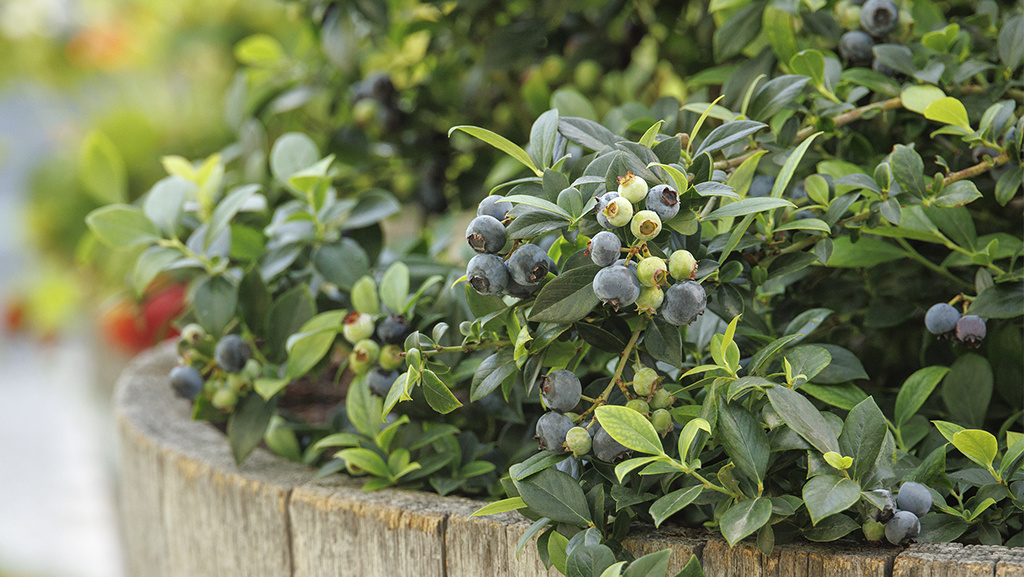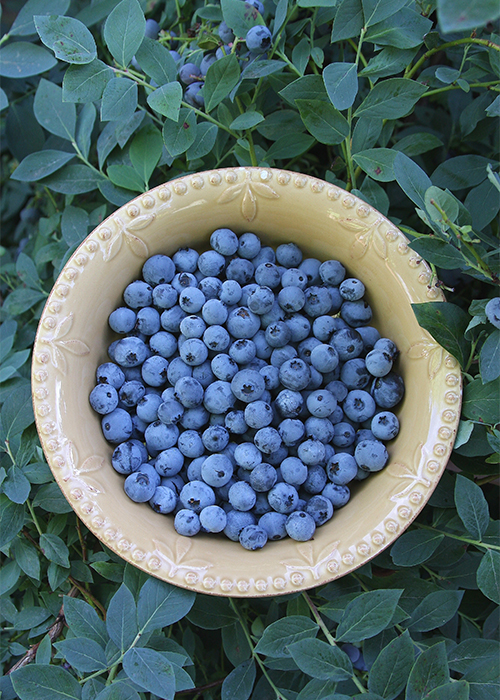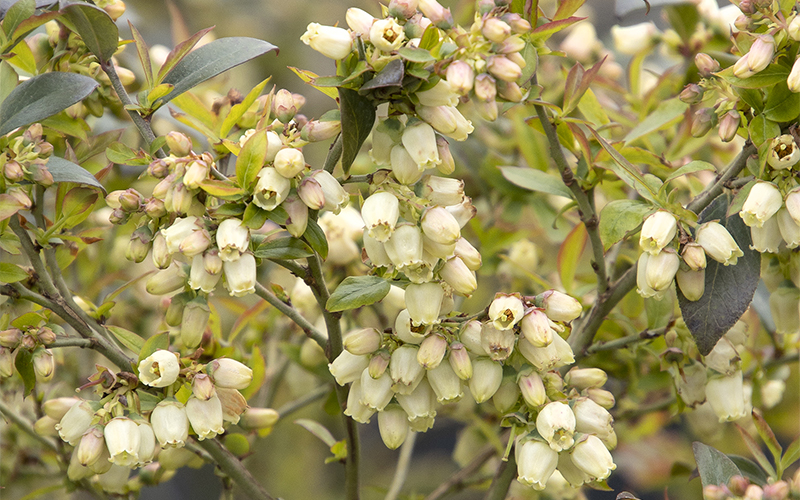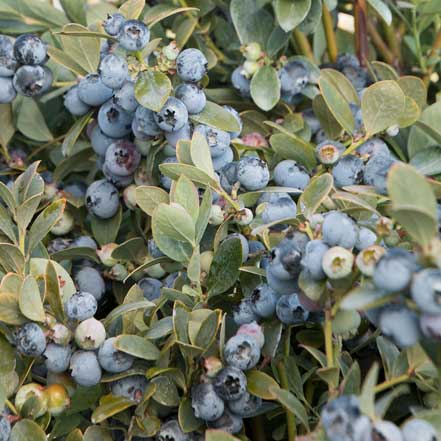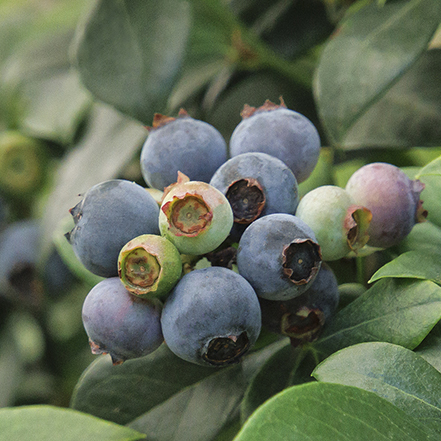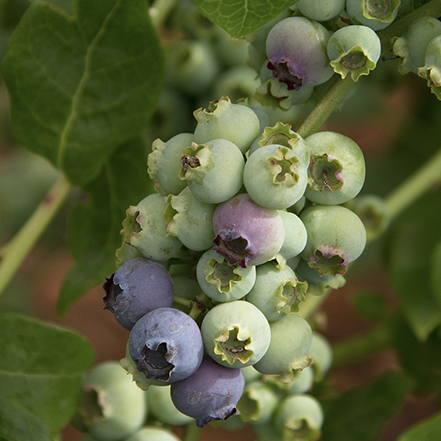Blueberries have become increasingly popular in home garden design. Not only do they provide delicious fruit, but they also make for beautiful and easy-to-care-for plants, making them a great option for novice gardeners. Their berries are packed with antioxidants and other nutrients, so they’re a healthy choice for those looking to incorporate more fruits into their diet while adding texture and interest to their gardens.
Common Blueberry Varieties
Blueberry bushes can vary greatly in size. Some varieties, like Bountiful™ Delight Blueberry, will only reach a height of 2-3 feet. While others, like Patriot Early Season Blueberry, can grow up to 8 feet tall.
Table of Contents
- Blueberry Planting Basics
- Watering and Mulching Blueberries
- Fertilizing Blueberries
- Pruning Blueberries
- Harvesting Blueberries
- Blueberries in Garden Design
- Common Blueberry Challenges
One of the most popular varieties of blueberries is the Northern Highbush (e.g., Northern Midseason Blueberry), known for its large, flavorful berries and ability to grow in a variety of climates. Other popular varieties include the Southern Highbush (e.g., Jubilee Midseason Blueberry), known for its disease resistance and adaptability, and the Rabbiteye, known for its ability to tolerate hot and dry conditions.
What are Chill Hours?
Winter chill hours are the total number of hours at 45 degrees or less between November and February. Some varieties of blueberries require more chill hours than others, with Northern Highbush generally needing more, and Southern Highbush needing less.
The majority of the United States gets enough chill hours to grow varieties that require even the most chill hours. The most southern parts of the country, however, should stick to low-chill varieties. (Southern California and Arizona, and the southern parts of the gulf states) If you are unsure, check with local retail nurseries, agricultural universities, county extension offices, and master gardeners to find the best varieties for your area.
No matter what variety you choose, there are some basic care guidelines that will help you grow blueberries confidently, and we'll go over everything you need to know right here. Plus, find the best blueberry varieties as well as one of our favorite blueberry recipes—Blueberry Spice Pie!
If you have some helpful insight that you’d like to share about growing blueberries (or a recipe!), please tag us on social media @MonroviaPlants.
Where and How to Plant Blueberries
When planting blueberries, the most important things to keep in mind are soil, sun exposure, moisture, and space requirements. Properly planting blueberry bushes is crucial for the health of the plant and for fruit production.
Can I grow blueberries in containers?
Yes! Blueberries are excellent for growing in containers. Get tips for growing blueberries in containers here.
Sun Exposure
Blueberries should be planted in full sun, although they can tolerate some shade.
Soil Needs
- Blueberries prefer acidic soil with a pH between 4.5 and 5.5.
- They also require well-drained soil, as they can't tolerate standing water.
- If you have heavy clay soil, you can amend the soil with organic matter such as compost to improve drainage.
Spacing and Planting
- Depending on the variety, blueberry bushes should typically be spaced 3-4 feet apart to allow for proper growth and air circulation.
- When planting, make sure to plant your blueberry bushes at the same level they were planted in the container and water well after planting.
It's also a good idea to plant multiple varieties of blueberries, as this will ensure better pollination and fruit production. Blueberries are self-sterile, meaning that they need another variety of blueberry to pollinate.
How to Water and Mulch Blueberries
Even though blueberries require well-drained soil, they also need consistent moisture to thrive, given that they have a shallow root system. So, it's important to water them regularly, but not too much.
- Using a soaker hose or drip irrigation system will allow the water to percolate into the soil without getting water on the leaves.
- Watering once or twice a week, depending on the weather, should be enough to keep the soil consistently moist.
- Test the soil before watering to avoid over-watering blueberries, as this can lead to root rot.
- As with other plants, try to water your blueberry bushes in the morning. This will give enough time for the water that does land on the leaves to dry before evening, which will minimize the chances of fungal diseases.
Proper mulching is also important, as it helps retain moisture in the soil, keeps the roots cool in the summer and warm in the winter, and helps suppress weeds.
- It's best to use an acidic mulch such as pine needles, oak leaves, or hemlock. These mulches will help the pH of the soil be in line with what blueberries prefer.
- Spread a 2-3 inch layer of mulch around the base of the blueberries, being careful not to pile the mulch against the stem of the plant.
- Reapply as necessary, usually once a year.
How to Fertilize Blueberries
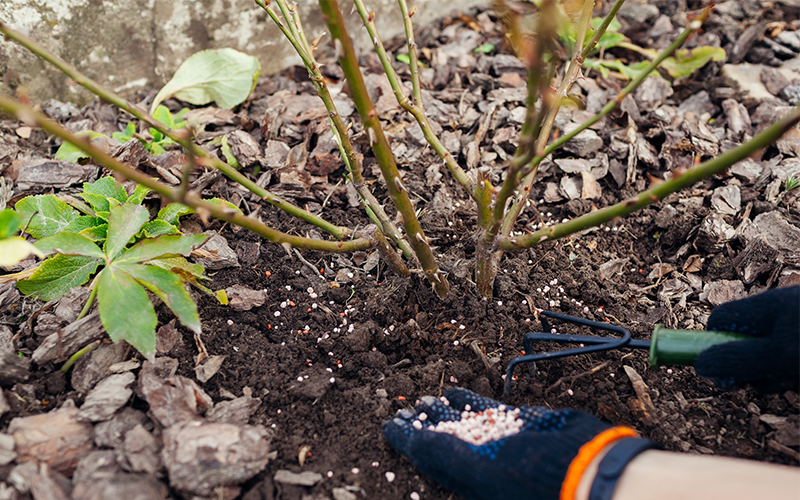
Fertilizing blueberries is also important for their growth and fruit production, and there are both chemical and natural methods you could consider.
- If you chose to go the chemical route, blueberries prefer an acidic fertilizer, such as one formulated for azaleas or rhododendrons. These fertilizers will help maintain the pH of the soil at the optimal level for blueberries.
- Using a slow-release fertilizer will provide a steady supply of nutrients to the plant over time.
- However, natural methods, such as using compost or applying seaweed or fish emulsion, can also be effective in providing the necessary nutrients for blueberry growth.
- Fertilize your blueberries in the spring, just before new growth begins. You can also fertilize again in mid-summer, after the fruit has set.
How to Prune Blueberries
Pruning your blueberry bushes helps improve air circulation, light penetration, and also reduces the chances of disease. And perhaps most importantly, it encourages fruit production!
- The first step to pruning is removing any dead, diseased, or damaged branches. Then prune enough of the “old wood” to encourage new growth; but not too much of the “old wood,” as their berries grow on “old wood” (i.e., last year’s growth). Doing this annually optimizes the chances of having a more productive and consistent harvest from year to year.
- This can be confusing for some, so many gardeners simply remove dead, diseased, and damaged branches, and then just prune out a few obviously old branches. It’s fairly easy to tell “old wood” from “new wood,” as “old wood” has a lighter, rougher texture and “new wood” is darker and smoother.
- Prune blueberries in late winter or early spring. Not only will this allow you to see the structure of your bushes more easily (e.g., what’s dead, diseased, or damaged and tell “old” from “new wood”), it’s also before new growth begins, which makes your pruning efforts easier.
When to Harvest Blueberries
Harvest blueberries when they are fully ripe and have a deep blue color.
- The berries should almost drop into your hand with a slight pinch. If you have to pull too hard, they are probably not ripe yet.
- They typically begin to ripen in mid-summer, depending on the variety of blueberry and your local climate.
- Harvesting in the morning is best, as that’s when berries are at their juiciest and freshest.
- It may take a few years after planting your blueberry bushes before you’ll have a bountiful harvest. So you’ll need to be patient.
How to Use Blueberries in Garden Design
Including blueberry bushes in your garden design not only provides tasty fruit, but also adds beauty and interest.
Design ideas for blueberry shrubs
- Blueberries have gorgeous spring flowers, so you can use them as a great early-spring color addition to your beds and borders.
- Blueberries can be used in a variety of ways: grown in containers, as a hedge, or as an ornamental shrub.
- Blueberries make great companion plants, as they can help improve the health and productivity of other fruits and vegetables.
- Blueberries are a great alternative to other fruits, as they are typically more disease-resistant and easy to care for.
Blueberries are the ideal candidate for use in a refined edible landscape design, where edible and non-edible plants are both used to achieve an abundant look and habitat. For example:
- Planting blueberries among native grasses and wildflowers create a naturalistic garden that not only provides food for you but wildlife as well (if you’re willing to share!).
- Blueberries can also be planted among more typical landscape shrubs, like azaleas, hydrangeas, and rhododendrons. These plants not only complement the blueberries in terms of color and texture, but they also enjoy the acidic soil environment that blueberries prefer.
Common Blueberry Challenges
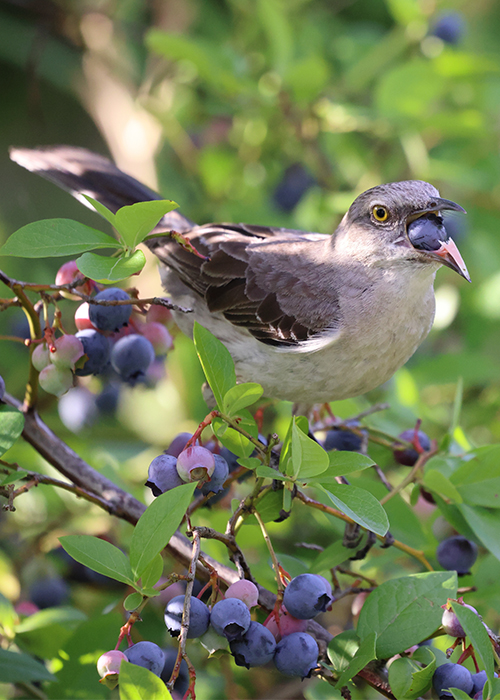
As with any plant, there are some challenges that you may face when growing blueberries.
Keeping birds and other critters from eating the berries before they ripen or before you have a chance to harvest them is probably the most commonly voiced challenge.
How to Keep Birds from Eating Blueberries
- One solution to this problem is to install netting around your blueberry bushes. This can be done by purchasing bird netting from a garden center and draping it over your bushes, making sure to secure it tightly to the ground to prevent critters from getting underneath.
- You could take it one step further by building a frame on which you drape the netting. This will not only keep the critters out, but it will also keep the netting from weighing down and potentially damaging the blueberry bush branches.
Keep an eye out for common insect pests and potential diseases
- If you see aphids or spider mites, you can control them using natural methods, such as introducing beneficial insects or using organic insecticides.
- To minimize the chances of diseases, it's important that you plant your blueberries in well-drained soil and avoid over-watering. If you notice signs of disease, take action immediately. This may include applying a fungicide, removing infected branches, improving drainage, or adjusting the soil pH.
Best Easy-Care Blueberries for Beauty and Fruit
Bountiful Blue®
Blueberry
An award-winning variety with the bluest of foliage! Pink-blushed flowers produce large, sweet, juicy berries on a compact, mounded shrub. Perfect for hedges or planting in large tubs. Self-fertile, though planting with another variety may increase yields. Needs only 150-200 winter chill hours. Full sun. Up to 4' tall. Zones 6-10.
Bountiful™
Delight Blueberry
An excellent blueberry for warm climates that performs well even in extreme heat, bearing small, aromatic, sweet fruit. New foliage emerges bright red, then matures to a deep, glossy green. The compact, bushy form makes it an excellent choice for the landscape, and could even be used to form an attractive hedge. Early to mid-season fruiting. Recommended chill: 300 - 500 hours. Full sun. Up to 3' tall and wide. Zones 8-10.
Northland
Midseason Blueberry
A midseason crop of delicious blueberries follows the profusion of showy pink-tinged white flowers. More productive than others due to larger size and fruit is best eaten fresh. Yellow, bronze, orange, and red fall color. An excellent hedge or specimen. Recommended chill: 800 - 1000 hours. Full sun. Up to 6' tall, 5' wide. Zones 3-7.
Blueberry Spice Pie Recipe
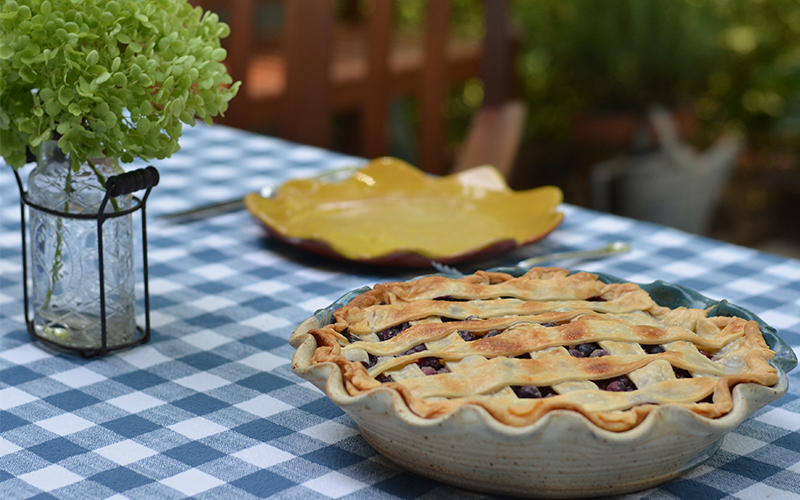
Let’s face it, most of us grow blueberry bushes for their delicious fruit. So, we thought we’d share one of our favorite blueberry recipes – Blueberry Spice Pie. We think that you’ll not only it to be lip-smacking good, but fairly easy to make, as well.
Blueberry Spice Pie
Ingredients
- 3/4 cup sugar + a little more to sprinkle on top
- 1/4 cup firmly packed brown sugar
- 1/2 cup all-purpose flour
- 1/2 teaspoon ground cinnamon
- 1/4 teaspoon ground allspice
- 1 tablespoon lemon juice
- 1 tablespoon melted butter
- 5 cups of fresh blueberries
- 2-pack refrigerated pie crust (or homemade pie crust, if you dare)
- Add a little milk to brush on the crust just before baking
Tools & Utensils
- Large mixing bowl
- Measuring cups
- Spoon to mix and knife to cut the crust
- 9” pie plate
- Rolling pin
- Pastry brush
Instructions
- Combine all ingredients (but the milk and pie crust, of course) in a large mixing bowl, tossing them together gently.
- Unroll one pie crust and lay on a 9” pie plate.
- Spoon mixture into pie shell.
- Roll out the other pie crust with a rolling pin and cut into strips.
- Arrange the strips in a lattice design on the pie, crimping the edges.
- Brush pastry lattice with milk.
- Sprinkle some sugar on top.
- Bake at 400 degrees for 45 minutes.
- During the last 20 minutes of baking, cover the edges of pie crust with tinfoil to shield it from burning.
That’s it. All that’s left to do now is to serve it up warm with a scoop of vanilla ice cream and enjoy. Yum!
About the Author and Designer
Doug Scott is the owner and lead designer at Redeem Your Ground, an exterior design firm, based in Atlanta, GA. Through his designs, Doug hopes to create outdoor spaces that reflect each clients wants to live outside at home. Doug and his wife, Brittany, also have a family, home & garden blog by the same name. They share stories, helpful information, and instructional how-to’s—hoping to enable and inspire others to live more fully at home.





